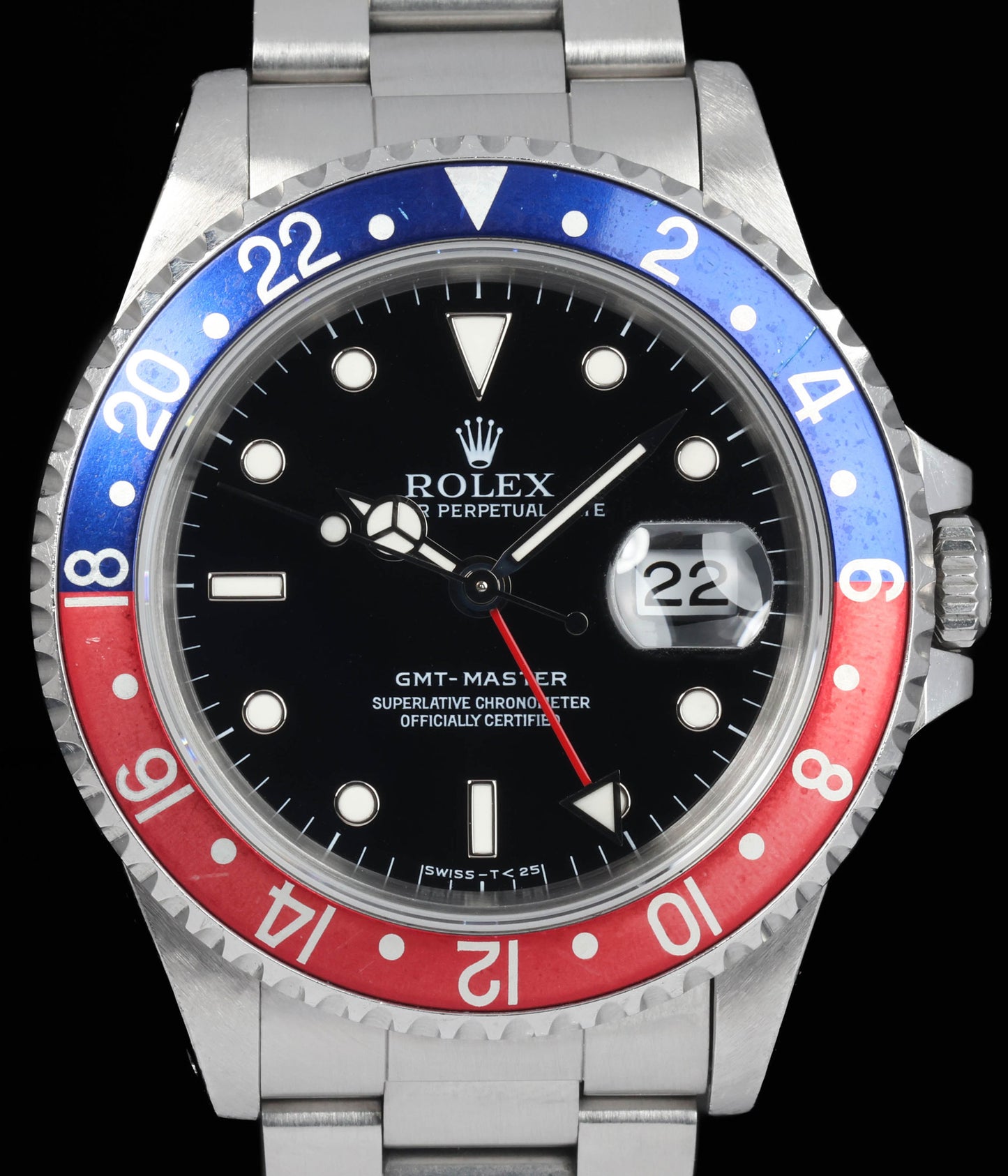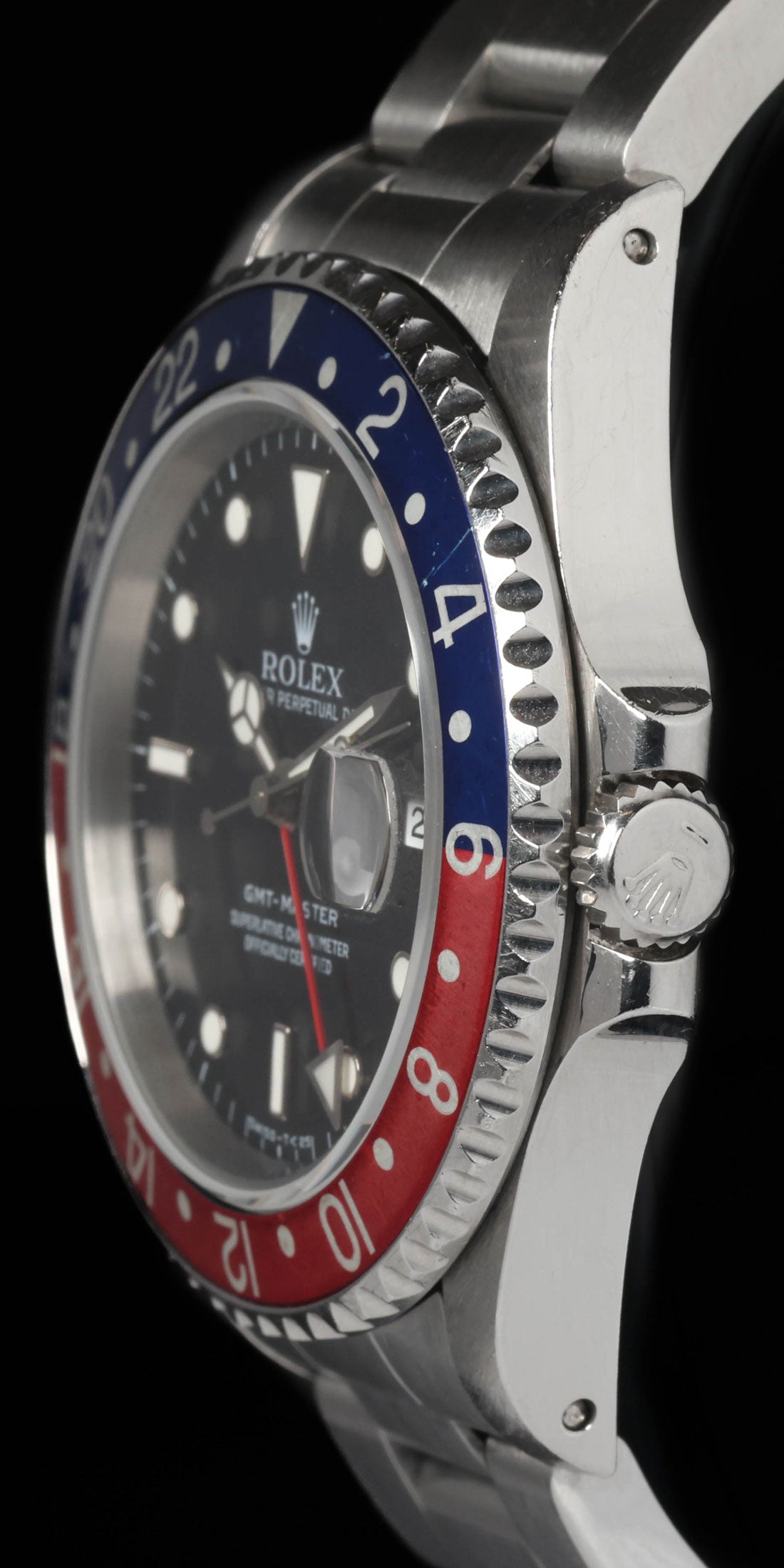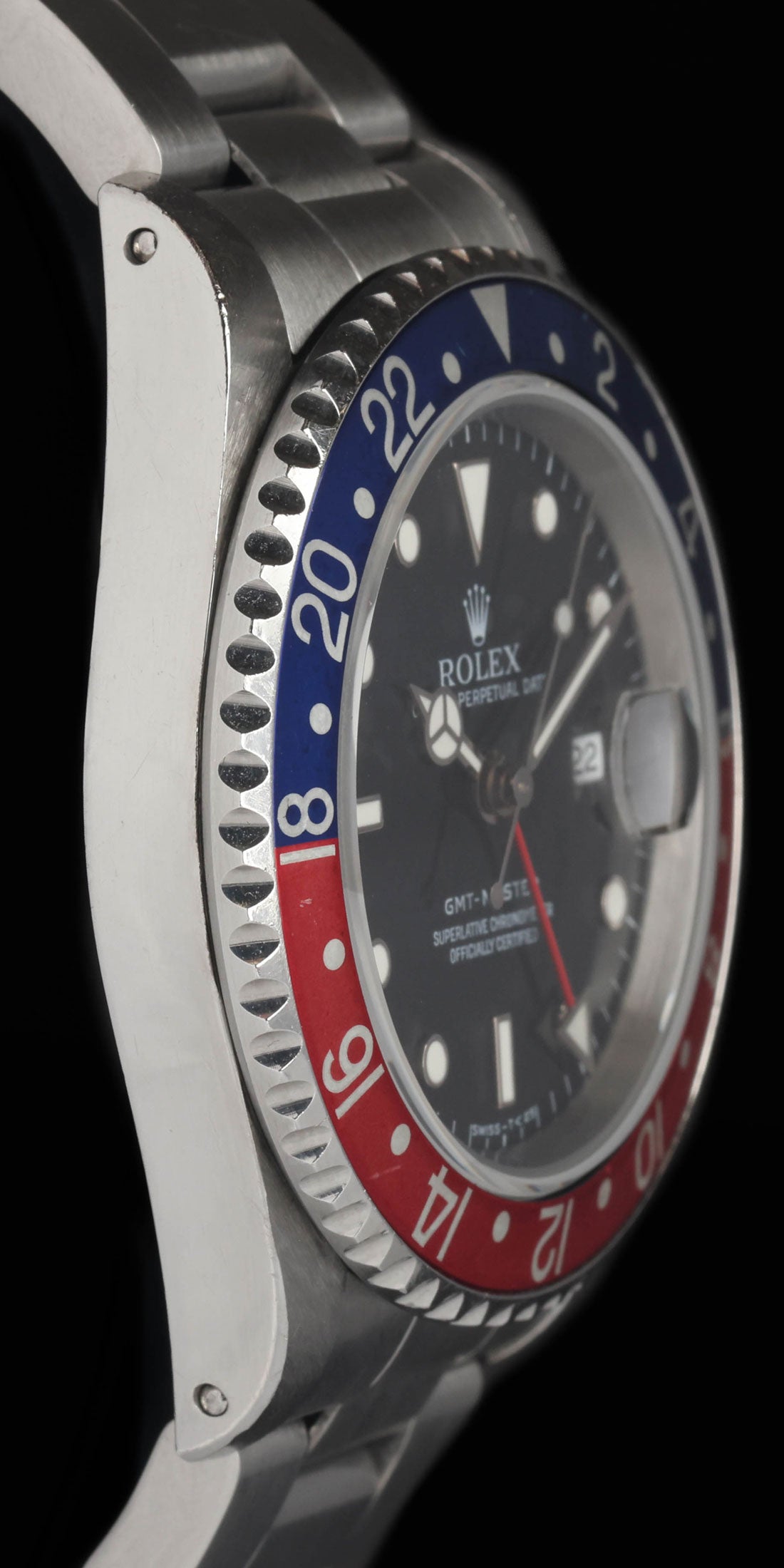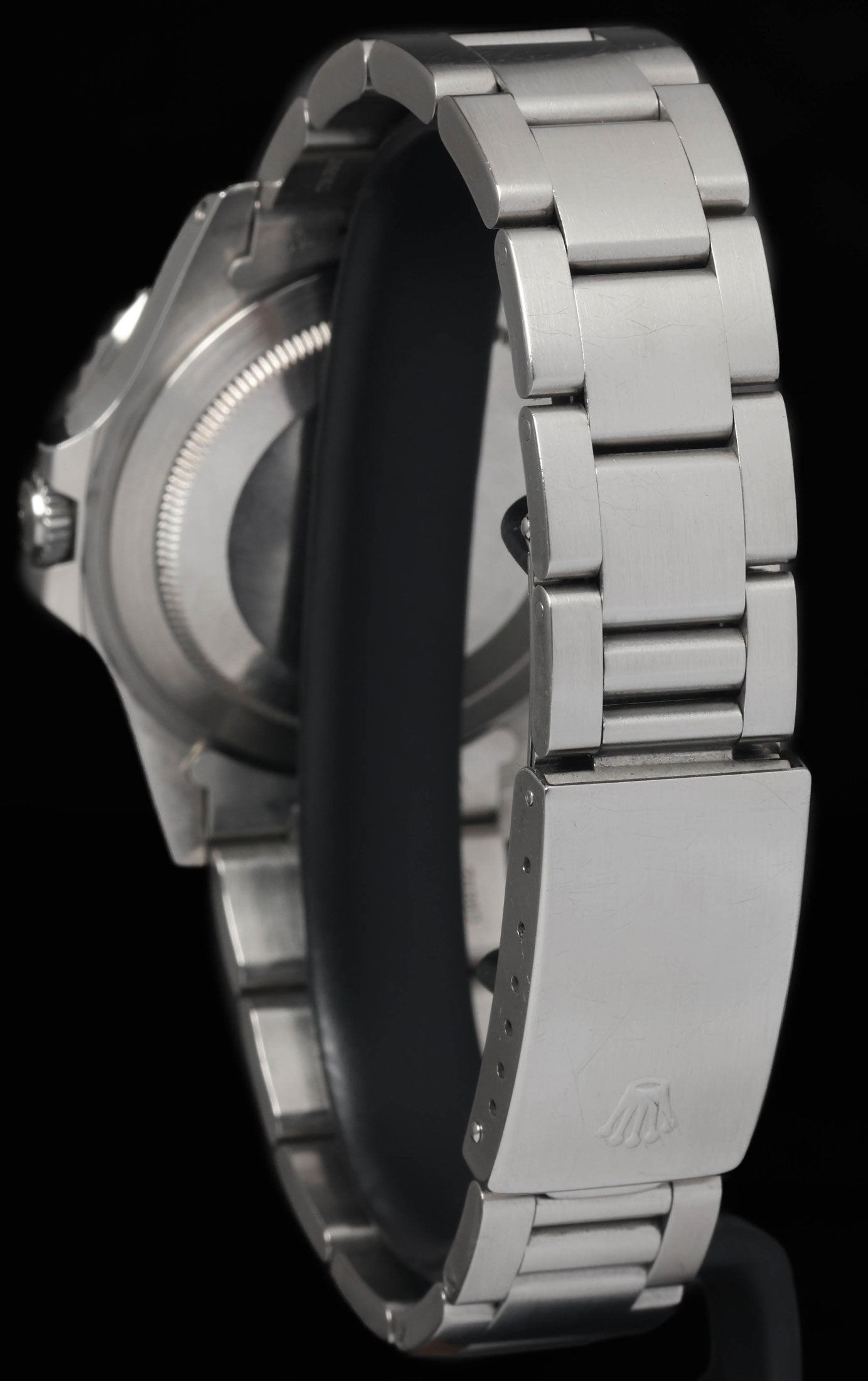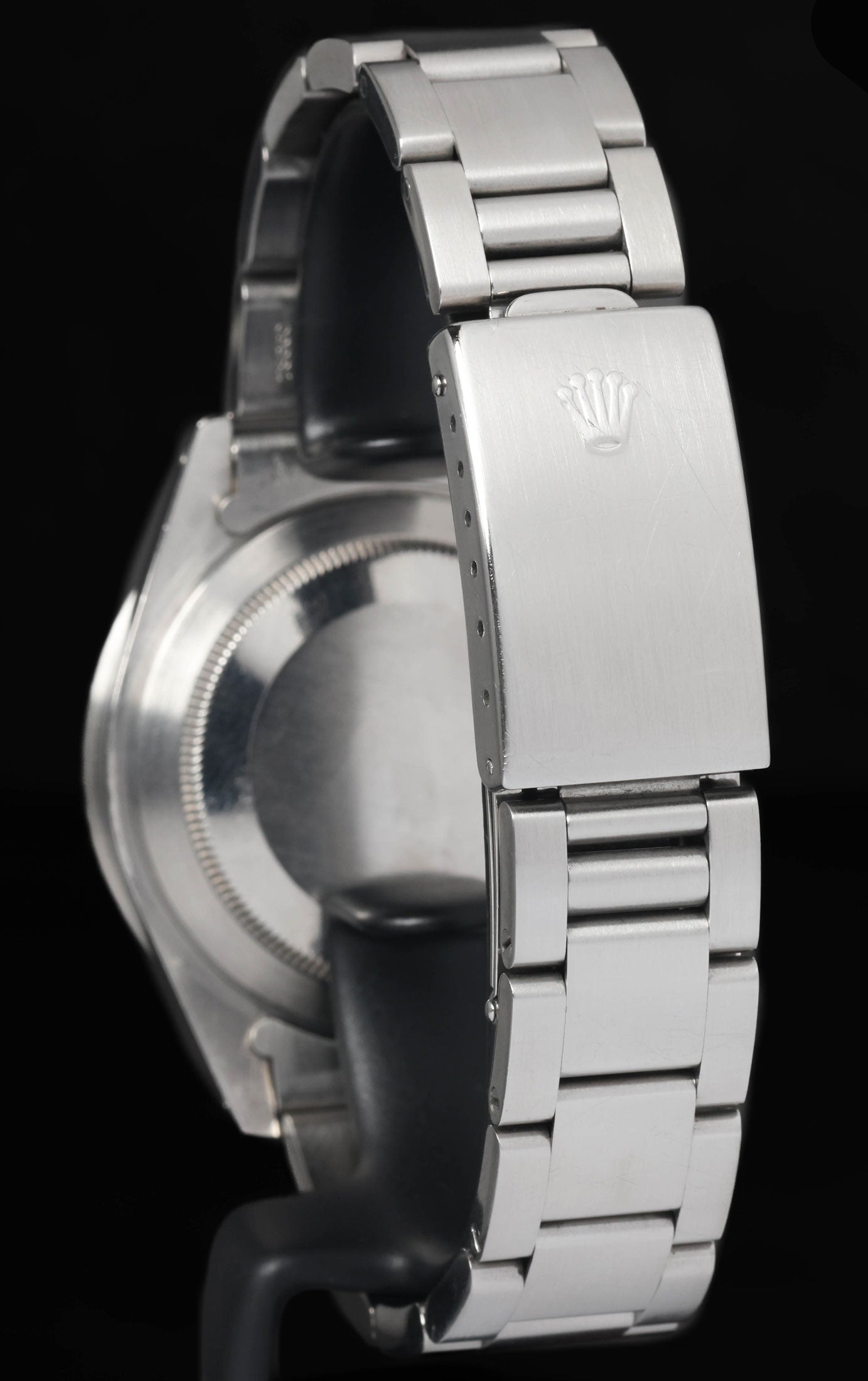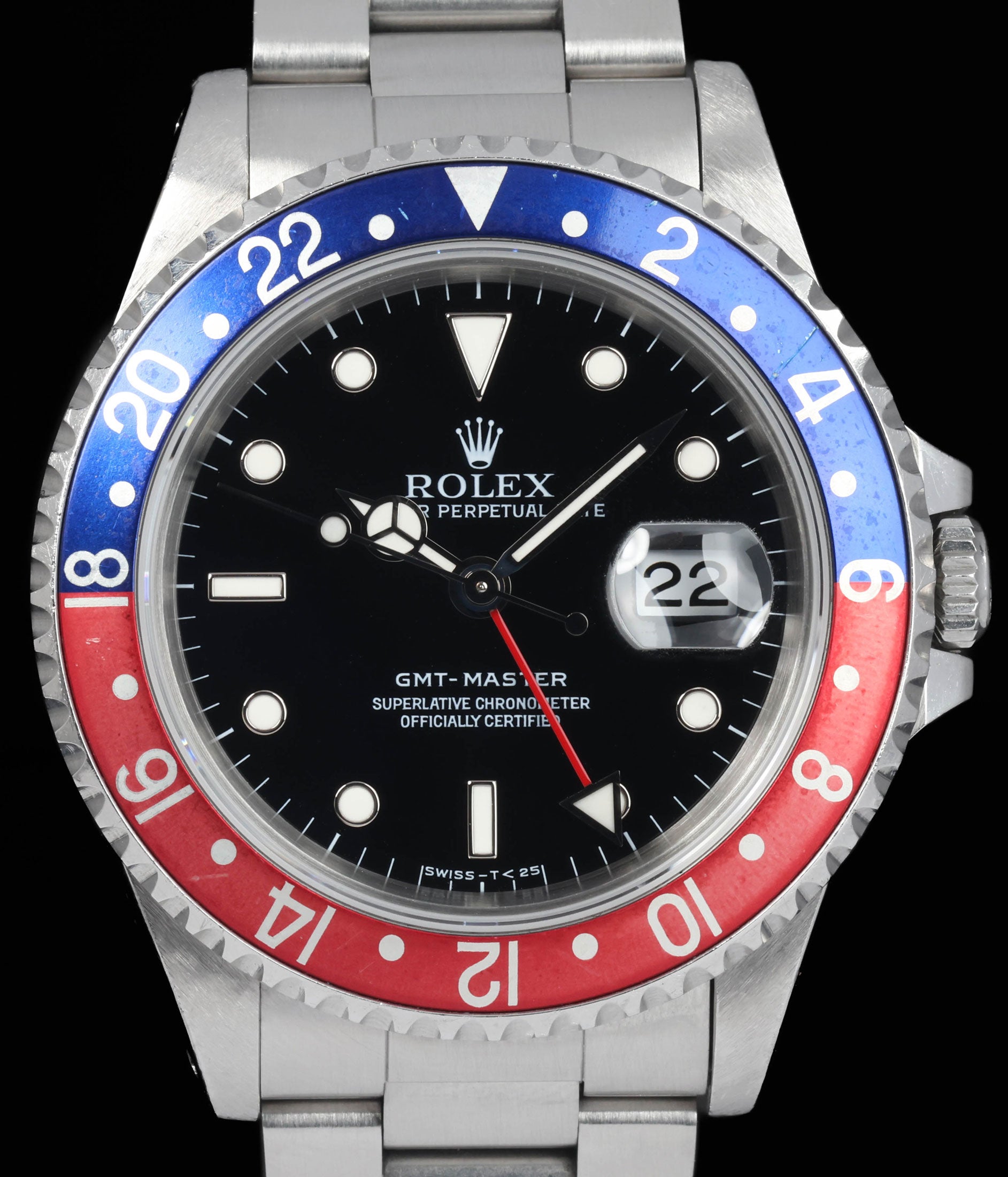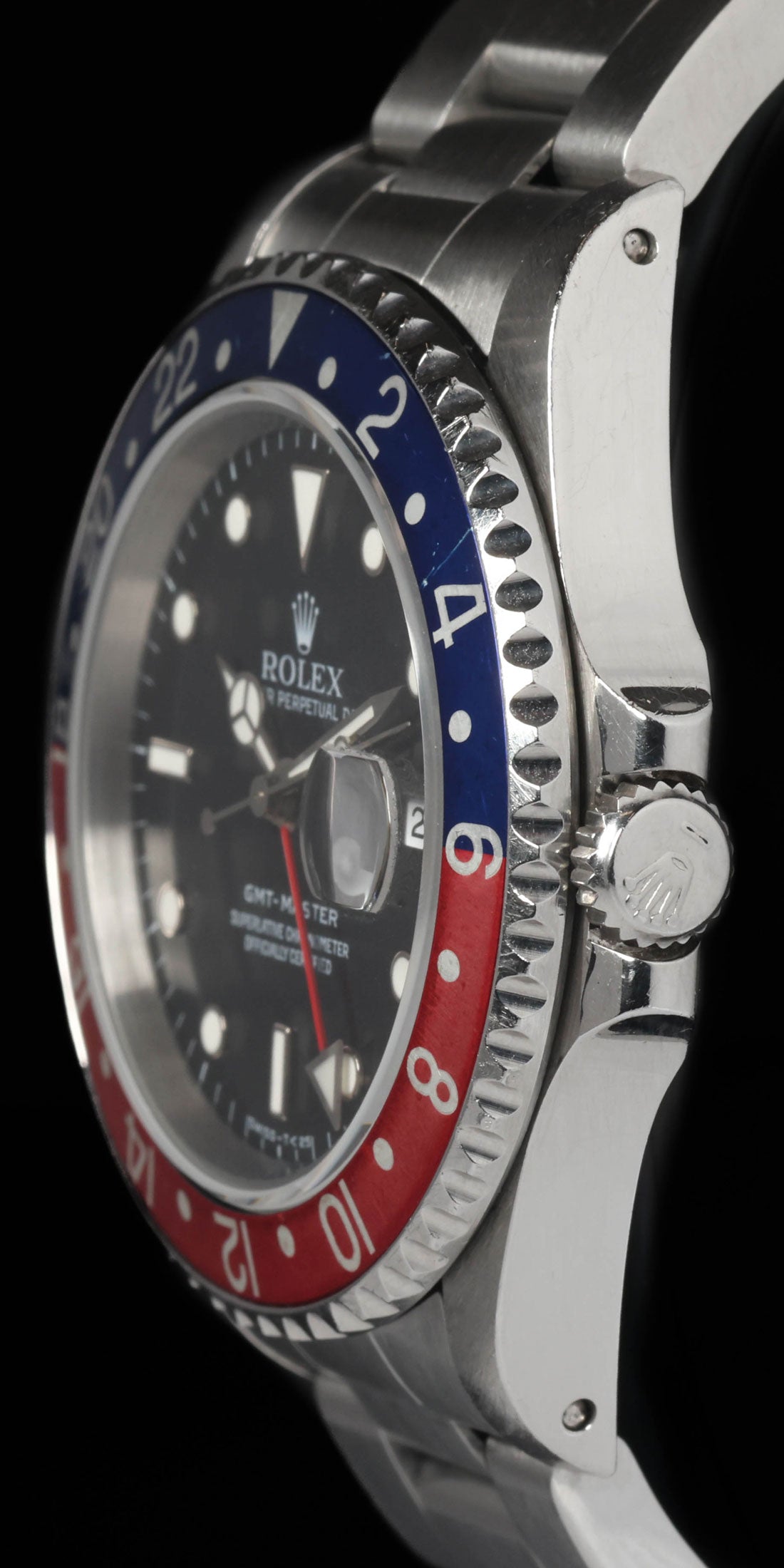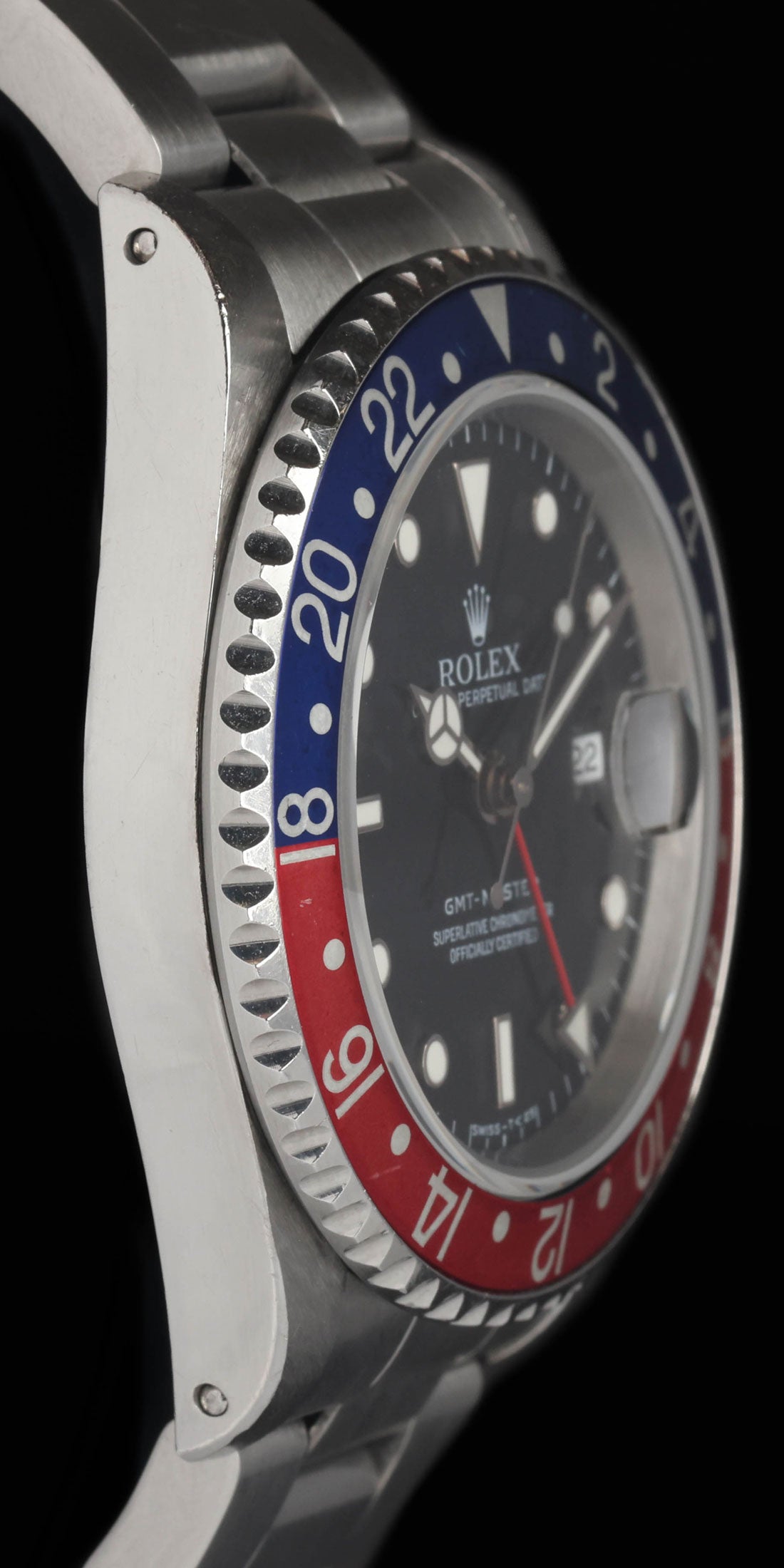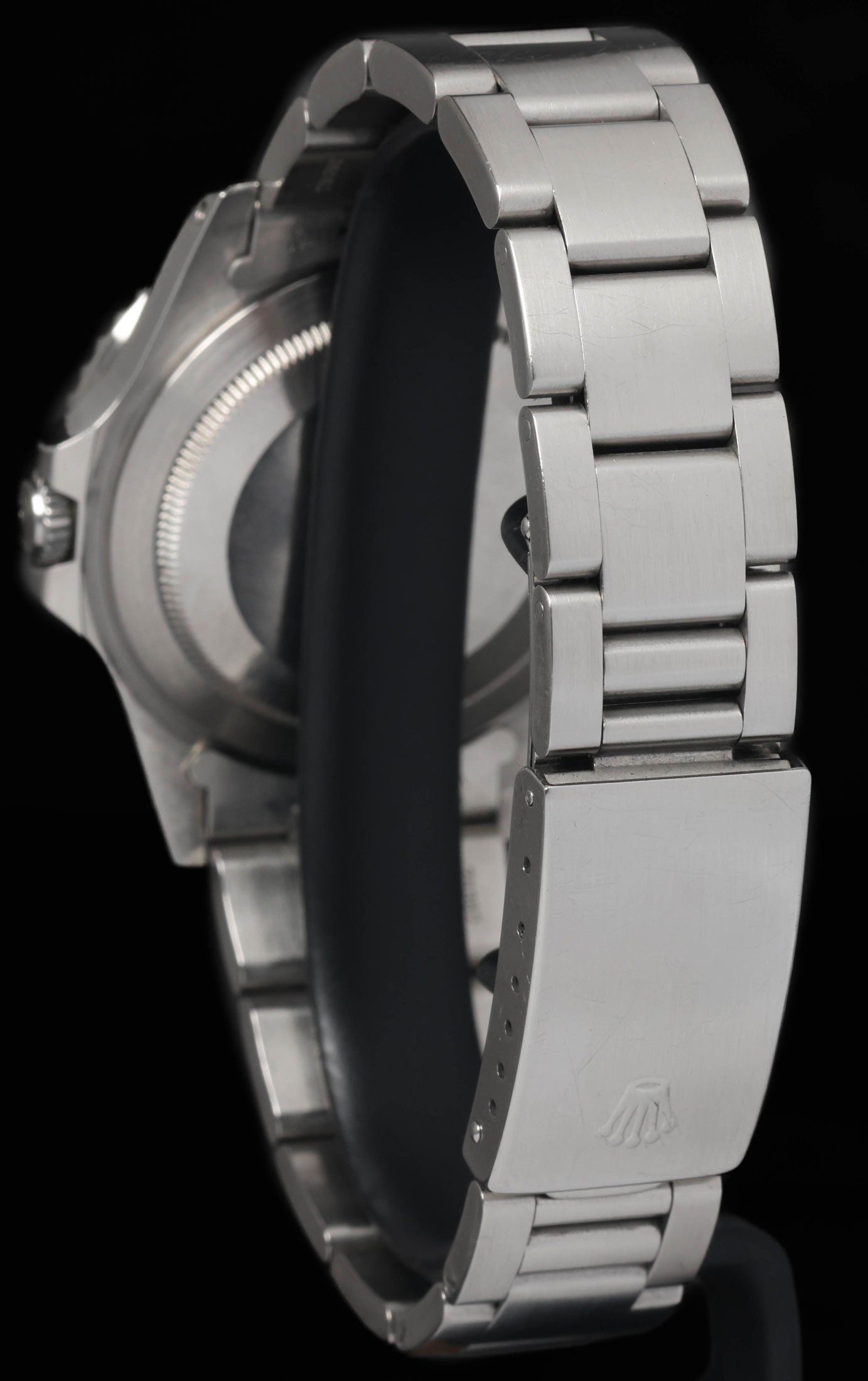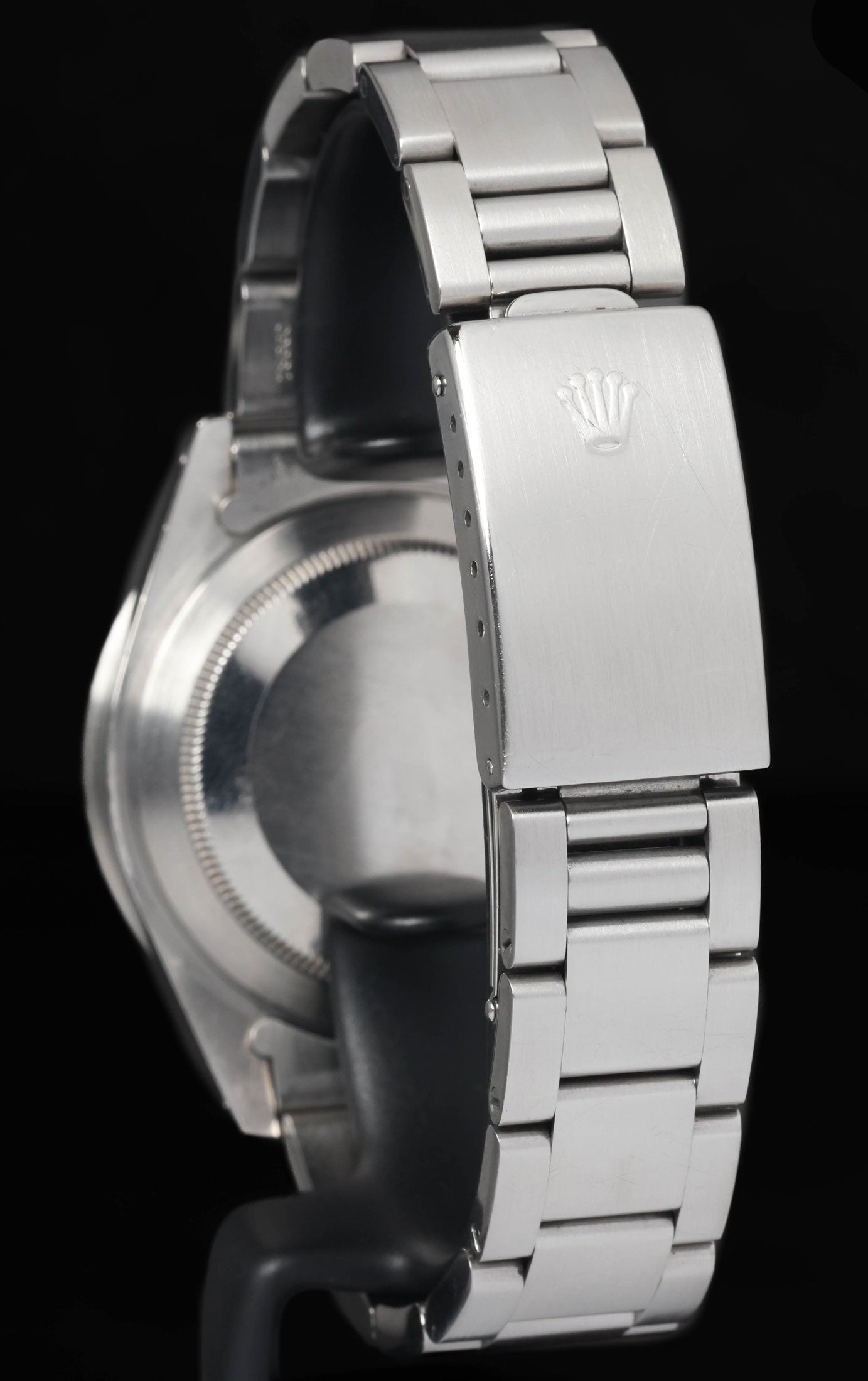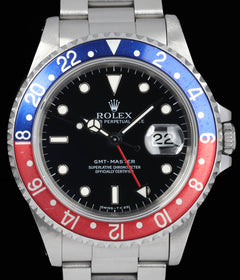Crown Vintage
Rolex GMT Master 16700 'Pepsi' 40mm 1993
Rolex GMT Master 16700 'Pepsi' 40mm 1993
Couldn't load pickup availability
Rolex GMT Master 16700 'Pepsi' 40mm 1993
The stainless steel Oyster case is in great condition, showing only light hairlines on both sides from careful wear. The overall profile remains strong with well-preserved lines and proportions.
The matching Oyster bracelet is in great condition, having been lightly polished in the past. Some stretch is present, consistent with age and use, but it remains secure and comfortable on the wrist. Surface hairlines are visible under close inspection.
The glossy black dial and matching hands are in very good condition, with crisp printing, clean luminous plots, and no visible blemishes. The luminous material remains intact and evenly preserved.
Overall, this example of the 16700 presents as a strong and attractive watch, with a well-kept case, solid bracelet, and dial and hands in very good form.
Share
Why we love this watch
Why we love this watch
Rolex GMT-Master 16700 “Pepsi”
Introduction
Produced for just over a decade from the late 1980s through the 1990s, it represents the final iteration of the original GMT-Master line before Rolex consolidated the range into the GMT-Master II. For this reason alone, the 16700 holds historical significance—it is both the end of one story and the prelude to another.
The Pepsi version of the 16700, with its iconic red-and-blue bezel insert, embodies everything that has made the GMT-Master such an enduring watch. It combines Rolex’s professional tool-watch ethos with unmistakable colour and character. Today, it is appreciated not only as the last of its type but also as a practical, wearable, and visually compelling GMT that bridges vintage charm and modern reliability.
The GMT-Master Legacy
The GMT-Master line traces its origins to the 1950s, when Rolex collaborated with Pan American World Airways during the dawn of commercial jet travel. The challenge was straightforward: airline crews needed a way to track two time zones simultaneously as they crossed oceans. Rolex’s solution was to add a 24-hour hand and a bi-coloured rotating bezel, allowing the wearer to read local and home time at a glance.
The original reference 6542 launched in 1954 with a bakelite bezel insert that was fragile and prone to cracking. By the late 1950s, Rolex introduced the reference 1675 with an aluminium insert, crown guards, and increased robustness. The 1675 went on to become one of the most recognisable Rolex sports models, produced for more than 20 years.
Following it were transitional references like the 16750 and 16753, which brought quickset date functionality and higher-beat movements. By the late 1980s, Rolex unveiled two different approaches: the GMT-Master 16700 and the GMT-Master II 16760, nicknamed the “Fat Lady.”
The 16700 kept the traditional GMT-Master format with a fixed 24-hour hand, while the GMT-Master II introduced an independently adjustable local-hour hand, allowing true three-time-zone functionality. Both models ran in parallel, but the 16700 remained the simpler and more affordable option until it was discontinued at the close of the decade.
Case and Bezel
The 16700 was housed in a 40mm stainless steel Oyster case, water resistant to 100 metres. The case design carried forward the classic proportions established by the 1675 and refined in the 16750. It combined brushed lugs on top with polished sides, a blend of toughness and subtle elegance that characterised Rolex tool watches of the period.
The watch’s defining feature was its aluminium Pepsi bezel insert. Red denoted the daylight hours, while blue signified night. This intuitive visual system made reading the second time zone quick and easy. The insert was housed in a bidirectional bezel with precise detents, allowing smooth adjustment.
Over the years, aluminium inserts developed their own patina. Reds could fade into salmon or pink hues, while blues could mellow into sky tones. Each insert aged differently, giving every watch unique character. This natural fading has become one of the most celebrated aspects of vintage GMT-Masters.
Dial and Hands
The dial of the 16700 reflected Rolex’s aesthetic during the late 1980s and 1990s. Glossy black with applied white gold hour markers filled with luminous material, it combined modern refinement with professional legibility.
At six o’clock, the luminous material changed depending on production period: early examples used tritium, marked with “SWISS – T<25.” By the mid-1990s, Rolex had transitioned to LumiNova, indicated by “SWISS” at the bottom of the dial, and eventually to Super-LumiNova, marked “SWISS MADE.” This evolution makes the 16700 an interesting study in Rolex’s luminous material history.
The hands followed the classic Mercedes-style design for the hour hand, pencil minute hand, and lollipop seconds hand. The fourth 24-hour hand was painted red with a luminous triangle tip, providing both a practical GMT reading and a flash of colour that echoed the bezel insert.
Movement: Calibre 3175
Inside the 16700 beat the Rolex calibre 3175, an automatic movement introduced specifically for this reference. It belonged to the 3000-series of Rolex calibres, known for their reliability and ease of service.
Key features included:
- 28,800 vibrations per hour.
- 31 jewels.
- 42-hour power reserve.
- Quickset date function.
- Fixed 24-hour hand.
The quickset date was a significant convenience, allowing the wearer to adjust the date independently of the time. However, the 24-hour hand was not independently adjustable, which distinguished the 16700 from the GMT-Master II references of the period. In practical terms, the wearer had to rotate the bezel to track a second time zone.
While mechanically simpler than the GMT-Master II, the calibre 3175 was robust, accurate, and perfectly suited to the watch’s purpose.
Bracelet Options
The 16700 was offered on both the Oyster and Jubilee bracelets, each bringing a different personality to the watch.
- The Oyster bracelet (reference 78360, later 78790) provided a sporty and professional look with three solid links, brushed outer surfaces, and polished sides.
- The Jubilee bracelet (reference 62510H) added refinement with its five-piece links, offering a dressier and more flexible fit on the wrist.
Both bracelets featured solid construction and Oysterlock clasps for security. The choice between them gave the 16700 versatility, making it equally at home in casual or more formal contexts.
The Pepsi Bezel and Its Iconic Status
The red-and-blue Pepsi bezel is one of the most iconic visual codes in watchmaking. Its origins were entirely functional, designed to help pilots distinguish day from night hours at a glance. But over time it became a cultural symbol of travel, adventure, and cosmopolitan style.
Worn by pilots, businessmen, celebrities, and world leaders, the Pepsi GMT-Master came to embody international life in the jet age. The colour scheme’s boldness made it instantly recognisable, while its practical readability anchored it in Rolex’s professional ethos.
The aluminium Pepsi insert of the 16700 continued this legacy, linking the watch to its earliest ancestors while carrying it forward into the modern Rolex era.
Wearability and Presence
On the wrist, the 16700 offers a timeless blend of proportions and practicality. Its 40mm case size strikes a balance—large enough for modern tastes yet slim and versatile compared to contemporary watches. The Oyster case hugs the wrist, and the choice of bracelet allows for personal expression.
The glossy dial provides clarity, with applied white gold markers adding subtle luxury. The Pepsi bezel injects character and colour, ensuring the watch is distinctive without being ostentatious. For many, the 16700 is the perfect daily GMT: simple, reliable, and quietly stylish.
Historical Importance
The 16700 is historically significant for several reasons. First, it is the last GMT-Master reference. After its discontinuation, Rolex consolidated the line under the GMT-Master II designation, meaning the fixed 24-hour hand design ended here. Second, it spans an important transition in Rolex’s production history—from tritium lume to LumiNova and eventually Super-LumiNova. Finally, it represents Rolex’s incremental refinement approach: familiar proportions, incremental improvements, and mechanical reliability.
Because its production run was relatively short compared to references like the 1675, the 16700 is less common on the secondary market. This adds to its appeal for those seeking a GMT-Master with both heritage and modern practicality.
Comparison with GMT-Master II of the Era
During its production, the 16700 existed alongside the GMT-Master II 16710. The latter introduced the independently adjustable local hour hand, making it possible to track three time zones simultaneously. It was a more technically advanced watch, but it also cost more.
The 16700 remained the entry point into the GMT line. Its fixed 24-hour hand meant it was truer to the original 1950s concept, and for many travellers, its functionality was more than sufficient. Some also prefer the quickset date of the 16700, which the 16710 lacked until later calibre upgrades.
This divergence between the two references underscores the 16700’s role as the last of the classic GMT-Masters.
Final Thoughts
The Rolex GMT-Master 16700 “Pepsi” is a watch that bridges eras. It retains the DNA of the original GMT concept, with its fixed 24-hour hand and iconic red-and-blue bezel. At the same time, it incorporates the refinements of the modern Rolex era—sapphire crystal, solid bracelets, calibre 3175 movement.
Its significance as the last GMT-Master makes it historically important. Its Pepsi bezel makes it instantly recognisable. And its proportions and versatility make it wearable in any setting.
Case & Bracelet
Case & Bracelet
- Case in great condition, light hairlines visible on both sides.
- Bracelet in great condition, lightly polished, some stretch.
Dial & Hands
Dial & Hands
Dial & hands are in very good condition.
Warranty & Condition
Warranty & Condition
Crown Vintage Watches provides a minimum 3-month mechanical warranty on pre-owned watches, from the date of purchase.
The warranty covers mechanical defects only.
The warranty does not cover damages such as scratches, finish, crystals, glass, straps (leather, fabric or rubber damage due to wear and tear), damage resulting from wear under conditions exceeding the watch manufacturer’s water resistance limitations, and damage due to physical and or accidental abuse.
Please note, water resistance is neither tested nor guaranteed.
Shipping and insurance costs for warranty returns to us must be covered by the customer. Returns must be shipped via traceable courier. Return shipment must be pre-paid and fully insured. Collect shipping will be refused. In case of loss or damages, the customer is liable.
Our Pledge
At Crown Vintage Watches, we stand by the authenticity of every product we sell. For added peace of mind, customers are welcome to have items independently authenticated at their own expense.
Condition
Due to the nature of vintage timepieces, all watches are sold as is. We will accurately describe the current condition and working order of all watches we sell to the best of our ability.
Shipping & Refund
Shipping & Refund
